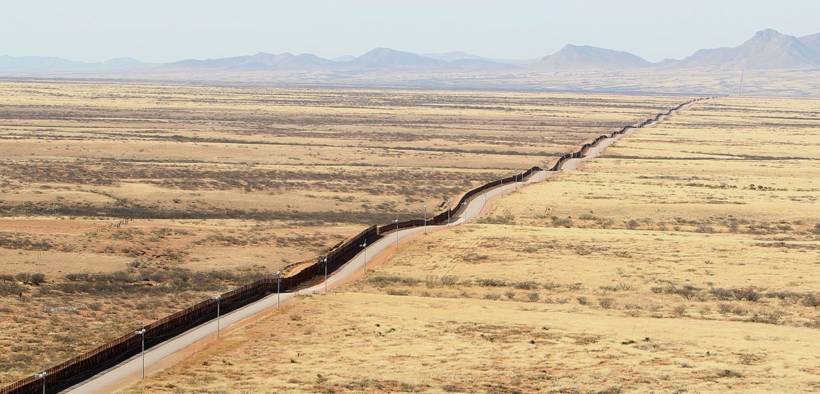Border Wall Construction Destroying Sacred Native American Burial Grounds

“They’re our ancestors. They’re our remnants of who we are as a people, throughout this whole area. And it’s our obligation, it’s our duty to do what is necessary to protect that.”
Construction of President Donald Trump’s border wall in Arizona has led to the disruption of a UNESCO ecological preserve containing Native American burial grounds, Christine Hauser reported for The New York Times. Construction crews have been blasting at Monument Hill, a resting place of Apaches. Furthermore, crews have bulldozed Quitobaquito Springs, a popular pilgrimage site.
Rep. Raúl M. Grijalva, D.-Ariz., visited the location Jan. 20 alongside members of the Thong O’odham Nation. Grijalva, chairman of the House Natural Resources Committee, warned that Organ Pipe Cactus National Monument might not be the last victim to border wall construction. UNESCO declared the location an international biosphere reserve in 1976.
“They’re our ancestors.”
“This administration is basically trampling on the tribe’s history — and to put it poignantly, it’s ancestry,” Grijalva told CBS News, EcoWatch reported.
The construction crews did not consult with the Tohono O’odham Nation prior to beginning work, he said. He tweeted a video rallying others to join a movement to stop the border wall.
“I just got back from the border,” Grijalva tweeted. “This week, Trump blew up a sacred Native American hill on public land to build his racist wall.”
The nation asked for a complete stop of construction at Monument Hill in addition to a two-mile buffer zone around UNESCO sites including Quitobaquito Springs, which serves as a natural water source.
“They’re our ancestors. They’re our remnants of who we are as a people, throughout this whole area. And it’s our obligation, it’s our duty to do what is necessary to protect that,” Tribal chairman Ned Norris Jr said.
Laiken Jordahl of the Center for Biological Diversity (CBD) said construction crews “butchered” Monument Hill by clearing “a large swath of land.”
The O’odham also consider saguaro cacti as the sacred embodiment of their ancestors, and construction crews are destroying them and well, he added.
Environment groups argue the construction risks damaging the underground aquifer, BBC News reported. The Washington Post obtained an internal report from the National Park Service that predicted the destruction of “up to 22 archeological sites within Organ Pipe alone.”
How is this Legal?
Washington is legally able to disrupt the ecological preserve thanks to the 2005 REAL ID Act, the BBC reported. The law allows the federal government to categorically dismiss laws that it deems as conflicting with US national security regulations. National security under Trump now entails building a wall along the US–Mexico border.
The Trump administration considered the border wall more important than 22 laws regulating the environment, public health, and ecological preservation, according to CBD. Last year, the Department of Homeland Security said it would build the all through Organ Pipe, Cabeza Prieta Nation Wildlife Refuge, San Bernardino National Wildlife Refuge, and Coronado National Memorial, among other designated areas.
In total, 12 waivers issued under the REAL ID Act allow for the administration to bulldoze historical sights, some of which feature artifacts as old as 10,000 years. CBD listed 41 laws Trump put aside in his quest for building a border wall.
Grijalva announced he will call a congressional hearing with the intention of repealing the 2005 law that gives Washington the authority to destroy protected lands.
According to the Customs and Border Patrol, “no biological, cultural, or historical sites” are at risk of destruction. CBP said it surveyed the area beforehand, USA Today reported.
“Based on the environmental surveys and stakeholder coordination completed, no biological, cultural or historical sites were identified within the project area, which consists of the 60-foot wide swath of land that extends from the international border north and is known as the Roosevelt Reservation,” a CPB statement said.
Jordahl disagrees, declaring Homeland Security “is not an authority on archaeological or cultural issues.”








Studies show that simply putting up a fence causes all sorts of disturbing effects on incects, animals, and plants. So I wouopd think humans are included in that list. wE ignore common sense so someone can make money, and so that another person can feel good about their ill conceived opinions. If it was not for enablers, there would be no wrong done. The enabler has always been the focus when applying lasting change in any circumstance, yet all the news and our family talk about his the actual one who got caught learning the crime. The border wall is a bad idea for many reasons, more so than anyone has the intelligence to discover because they bare too busy going along instead of stoping and listening, feeling, seeing; hence we are not using our senses.
Two comments:
The border wall is 50 years too late in the making.
Bulldozers clearing “vacant” land for urban expansion or industrial projects not uncommonly unearth long-forgotten post-colonization graveyards that once were maintained by small towns and settlements of “white” Americans of various generations. Stone Age cultural relics are no more “sacred” than any other. We can say, with neither prejudice or advocacy, “Sic transit.”
The article blames Trump but the picture of the wall is dated back to Obama years in the office, 25 January 2011. What am I missing here?